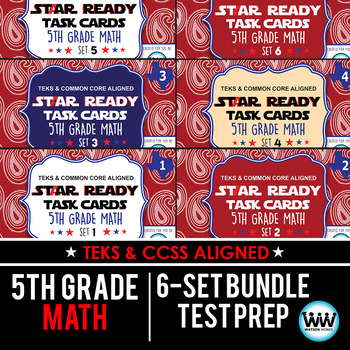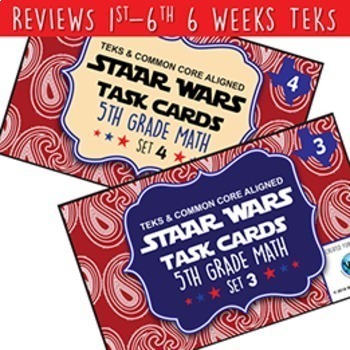SETS 1-6 BUNDLE - STAR READY 5th Grade Math Task Cards - STAAR / TEKS-aligned
- Zip
What educators are saying
Products in this Bundle (6)
showing 1-5 of 6 products
Description
*5th GRADE STAAR MATH TASK CARDS FOR THE ENTIRE SCHOOL YEAR!*
**SAVE 20% WHEN YOU PURCHASE THIS BUNDLE!**
***ALIGNED WITH MOST UPDATED MATH TEKS!***
***************************************************************************
You asked, and we listened! Because of the success customers had with our 3rd & 4th grade STAAR Wars Task Cards, we had multiple 5th grade teachers contact us, asking us to create 5th grades sets, too. So, we’re happy to finally introduce our new STAAR Wars 5th Grade Math Task Cards!!
Don’t wait until right before the end-of-year STAAR or other state assessment to get your students ready for the test! Prepare them each 6 weeks of school with our STAAR Wars 5th Grade Math Task Cards! This BUNDLE includes sets 1-6 for the 1st, 2nd, 3rd, 4th, 5th, and 6th 6 weeks of school.
Each set includes 24 task cards aligned with 5th grade math TEKS and common core standards and are perfect for assessing where your students are and where you need to go for the next 6 weeks of school.
These rigorous, higher-level thinking questions are made in STAAR format, have multiple choice answers, and address these skills:
Set 1:
•Apply mathematics to problems arising in everyday life, society and the workplace.
•Use a problem-solving model.
•Select tools and techniques to solve problems.
•Communicate mathematical ideas, reasoning, and their implications using multiple representations, including symbols, diagrams, graphs, and language as appropriate.
•Solve with proficiency for quotients of up to a four-digit dividend by a two-digit divisor using strategies and the standard algorithm.
•Add and subtract positive rational numbers fluently.
•Identify prime and composite numbers.
•Represent and solve multi-step problems involving the four operations with whole numbers using equations with a letter standing for the unknown quantity.
•Describe the meaning of parentheses and brackets in a numeric expression.
•Simplify numerical expressions that do not involve exponents, including up to two levels of grouping.
Standards Covered:
•TEKS - 5.1A, 5.1B, 5.1C, 5.1D, 5.3A, 5.3B, 5.3C, 5.3K, 5.4A, 5.4B, 5.4E, 5.4F
•CCSS - 4.MD.A.2, 4.OA.A.3, 4.OA.B.4, 5.NBT.B.5, 5.NBT.B.6, 5.NBT.B.7, 5.NF.A.1, 5.OA.A.1, 5.OA.A.2
Set 2:
•Add and subtract positive rational numbers fluently.
•Apply mathematics to problems arising in everyday life, society, and the workplace.
•Balance a simple budget.
•Compare and order two decimals to thousandths and represent comparisons using the symbols >, <, or =.
•Define income tax, payroll tax, sales tax, and property tax.
•Describe actions that might be taken to balance a budget when expenses exceed income.
•Develop a system for keeping and using financial records.
•Estimate to determine solutions to mathematical and real-world problems involving addition, subtraction, multiplication, or division.
•Explain the difference between gross income and net income.
•Identify the advantages and disadvantages of different methods of payment, including check, credit card, debit card, and electronic payments.
•Represent multiplication of decimals with products to the hundredths using objects and pictorial models, including area models.
•Represent quotients of decimals to the hundredths, up to four-digit dividends and two-digit whole number divisors, using objects and pictorial models, including area models.
•Represent, compare, and order positive rational numbers and understand relationships as related to place value.
•Round decimals to tenths or hundredths.
•Select tools and techniques to solve problems.
•Simplify numerical expressions that do not involve exponents, including up to two levels of grouping.
•Solve for products of decimals to the hundredths, including situations involving money, using strategies based on place-value understandings, properties of operations, and the relationship to the multiplication of whole numbers.
•Solve for quotients of decimals to the hundredths, up to four-digit dividends and two-digit whole number divisors, using strategies and algorithms, including the standard algorithm.
•Use a problem-solving model.
Standards Covered:
•TEKS - 5.1, 5.1A, 5.1B, 5.1C, 5.1D, 5.1E, 5.1F, 5.1G, 5.2, 5.2B, 5.2C, 5.3A, 5.3D, 5.3E, 5.3F, 5.3G, 5.3K, 5.4F, 5.10A, 5.10B, 5.10C, 5.10D, 5.10E, 5.10F
•CCSS - 5.NBT.A.3.A, 5.NBT.A.3.B, 5.NBT.A.4, 5.NBT.B.7, 5.OA.A.1, CEE.1.4.9, CEE.1.12.7, CEE.2.4.2, CEE.2.4.7, CEE.2.8.3
Set 3:
• Add and subtract positive rational numbers fluently.
• Analyze mathematical relationships to connect and communicate mathematical ideas.
• Apply mathematics to problems arising in everyday life, society, and the workplace.
• Create and use representations to organize, record, and communicate mathematical ideas.
• Divide whole numbers by unit fractions and unit fractions by whole numbers.
• Estimate to determine solutions to mathematical and real-world problems involving addition, subtraction, multiplication, or division.
• Represent and solve addition and subtraction of fractions with unequal denominators referring to the same whole using objects and pictorial models and properties of operations.
• Represent and solve multiplication of a whole number and a fraction that refers to the same whole using objects and pictorial models, including area models.
• Represent division of a unit fraction by a whole number and the division of a whole number by a unit fraction such as 1/3 ÷ 7 and 7 ÷ 1/3 using objects and pictorial models, including area models.
• Represent quotients of decimals to the hundredths, up to four-digit dividends and two-digit whole number divisors, using objects and pictorial models, including area models.
• Represent the value of the digit in decimals through the thousandths using expanded notation and numerals.
• Select tools and techniques to solve problems.
• Simplify numerical expressions that do not involve exponents, including up to two levels of grouping.
• Use a problem-solving model.
Standards Covered:
•TEKS - 5.1A, 5.1B, 5.1C, 5.1E, 5.1F, 5.3A, 5.3F, 5.3H, 5.3I, 5.3J, 5.3K, 5.3L, 5.4A, 5.4F
•CCSS - 5.NBT.B.7, 5.NF.A.1, 5.NF.A.2, 5.NF.B.4, 5.NF.B.6, 5.NF.B.7, 5.NF.B.7.C, 5.OA.A.1
Set 4:
• Classify two-dimensional figures in a hierarchy of sets and subsets using graphic organizers based on their attributes and properties.
• Describe the key attributes of the coordinate plane, including perpendicular number lines (axes) where the intersection (origin) of the two lines coincides with zero on each number line and the given point (0, 0); the x-coordinate, the first number in an ordered.
• Describe the process for graphing ordered pairs of numbers in the first quadrant of the coordinate plane.
• Determine the volume of a rectangular prism with whole number side lengths in problems related to the number of layers times the number of unit cubes in the area of the base.
• Generate a numerical pattern when given a rule in the form y = ax or y = x + a and graph.
• Graph in the first quadrant of the coordinate plane ordered pairs of numbers arising from mathematical and real-world problems, including those generated by number patterns or found in an input-output table.
• Recognize a cube with side length of 1 unit as a unit cube having 1 cubic unit of volume and the volume of a 3-dimensional figure as the number of unit cubes (n cubic units) needed to fill it with no gaps or overlaps if possible.
• Recognize the difference between additive and multiplicative numerical patterns given in a table or graph.
• Represent and solve problems related to perimeter and/or area and related to volume.
• Solve problems by calculating conversions within a measurement system, customary or metric.
• Use concrete objects and pictorial models to develop the formulas for the volume of a rectangular prism, including the special form for a cube (V=l x w x h, V= s x s x s, and V=Bh).
Standards Covered:
•TEKS - 5.4C, 5.4D, 5.4G, 5.4H, 5.5A, 5.6A, 5.6B, 5.7A, 5.8A, 5.8B, 5.8C
•CCSS - 4.MD.A.3, 5.G.A.1, 5.G.A.2, 5.G.B.3, 5.MD.A.1, 5.MD.C.3.B, 5.MD.C.4, 5.MD.C.5.A, 5.MD.C.5.B, 5.MD.C.5.C, 5.OA.B.3
Set 5:
•Adding and subtracting positive rational numbers
•Analyzing mathematical relationships to connect & communicate mathematical ideas
•Applying mathematics to problems arising in everyday life, society, & the workplace
•Communicating mathematical ideas, reasoning, & their implications using multiple representations
•Dividing whole numbers by unit fractions and unit fractions by whole numbers
•Representing & solving multiplication of a whole number and a fraction that refers to the same whole
•Representing categorical data with bar graphs or frequency tables and numerical data, including data sets, dot plots, and stem-and-leaf plots
•Representing discrete paired data on a scatterplot
•Simplifying numerical expressions that do not involve exponents, including up to two levels of grouping
•Solving for products of decimals to the hundredths
•Solving for quotients of decimals to the hundredths, up to four-digit dividends and two-digit whole number divisors
•Solving one- and two-step problems using data from a frequency table, dot plot, bar graph, stem-and-leaf plot, or scatterplot
•Using a problem-solving model
Standards Covered:
•TEKS - 5.1A, 5.1B, 5.1D, 5.1F, 5.3E, 5.3G, 5.3I, 5.3K, 5.3L, 5.4F, 5.9A, 5.9B, 5.9C
•CCSS - 5.MD.B.2, 5.NBT.B.5, 5.NBT.B.6, 5.NF.A.1, 5.NF.B.3, 5.NF.B.7.A, 5.NF.B.7.B, 5.NF.B.7.C, 5.OA.A.2
Set 6:
•Adding and subtracting positive rational numbers fluently
•Dividing whole numbers by unit fractions and unit fractions by whole numbers
•Estimating to determine solutions to mathematical and real-world problems involving addition, subtraction, multiplication, or division
•Representing & solving addition and subtraction of fractions with unequal denominators referring to the same whole
•Representing & solving multiplication of a whole number and a fraction that refers to the same whole
•Representing multiplication of decimals with products to the hundredths
•Representing quotients of decimals to the hundredths, up to four-digit dividends and two-digit whole number divisors
•Simplifying numerical expressions that do not involve exponents, including up to two levels of grouping
•Solving for products of decimals to the hundredths
•Solving for quotients of decimals to the hundredths, up to four-digit dividends and two-digit whole number divisors
Standards Covered:
•TEKS - 5.3A, 5.3D, 5.3E, 5.3F, 5.3G, 5.3H, 5.3I, 5.3K, 5.3L, 5.4F
•CCSS - 4.NBT.B.4, 4.OA.A.3, 5.NBT.B.7, 5.NF.A.2, 5.NF.B.3, 5.NF.B.7, 5.OA.A.1
Instructions are included for 3 methods of review: task cards review in centers/groups/pairs/individuals, a SCOOT game, and a "Be the Teacher" game, but these cards can be used in a variety of other ways to meet your needs.
We hope you enjoy them, and we’d love to hear your feedback! :)
Follow us on TpT, Facebook, Instagram and/or Pinterest to be alerted when new products or sales are available.
~Heather & Ashley
Watson Works, LLC
*Full preview of the product available by selecting the preview button above.
**You may also be interested in our STAAR Wars 5th Grade Reading BUNDLE , as well!
Terms of Use:
© 2016 Watson Works, LLC. Except as permitted under the United States Copyright Act, no part of this publication may be reproduced, stored, or distributed in any form or by any means (mechanically, electronically, recording, etc.) without the prior written consent of Watson Works, LLC. Purchasing this product in digital form from the Watson Works store on TeachersPayTeachers.com licenses one teacher to use this product in his/her classroom or for personal use. Additional licenses must be purchased for additional teachers to use this product. Made in the USA. All rights reserved.




